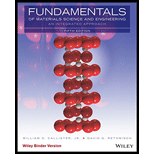
Fundamentals of Materials Science and Engineering, Binder Ready Version: An Integrated Approach
5th Edition
ISBN: 9781119175483
Author: William D. Callister Jr., David G. Rethwisch
Publisher: WILEY
expand_more
expand_more
format_list_bulleted
Question
Chapter 14.14, Problem 1QP
To determine
To cite:
The advantages and disadvantages of hot working and cold working.
Expert Solution & Answer
Answer to Problem 1QP
The advantages and disadvantages of hot working and cold working is given below:
Explanation of Solution
Hot working:
Advantages:
- 1. Larger deformations are achievable and it can be repeated.
- 2. It requires less energy to achieve the required deformation as compared to cold working.
- 3. The grain structure of the material was refined. Thus, the
mechanical properties of the material was improved.
Disadvantages:
- 1. Hot working carried out at high temperatures this causes surface oxidation which gives poor surface finish.
- 2. Difficult to achieve closest dimensional tolerances.
- 3. Loss of metal during hot working.
Cold working:
Advantages:
- 1. High quality of surface finished can be achieved.
- 2. Variety of mechanical properties can be achieved.
- 3. Close dimensional tolerances achieved easily.
Disadvantages:
- 1. Ductility of the material was reduced.
- 2. The cold working process is quiet complicated and expensive.
- 3. It require more energy to achieve the required deformation.
Want to see more full solutions like this?
Subscribe now to access step-by-step solutions to millions of textbook problems written by subject matter experts!
Students have asked these similar questions
Solve this question
Determine the voltage across A and B in the circuit given below:
An inductive coil having negligible resistance and 0.1H inductance is connected a supply of 220V, 50 Hz. Calculate (a) Inductive reactance, (b) RMS value of Current, (c) Power consumed, (d) Power factor, (e) Write down the equations for voltage and current.
Chapter 14 Solutions
Fundamentals of Materials Science and Engineering, Binder Ready Version: An Integrated Approach
Ch. 14.14 - Prob. 1QPCh. 14.14 - Prob. 2QPCh. 14.14 - Prob. 3QPCh. 14.14 - Prob. 4QPCh. 14.14 - Prob. 5QPCh. 14.14 - Prob. 6QPCh. 14.14 - Prob. 7QPCh. 14.14 - Prob. 8QPCh. 14.14 - Prob. 9QPCh. 14.14 - Prob. 10QP
Ch. 14.14 - Prob. 11QPCh. 14.14 - Prob. 12QPCh. 14.14 - Prob. 13QPCh. 14.14 - Prob. 14QPCh. 14.14 - Prob. 15QPCh. 14.14 - Prob. 16QPCh. 14.14 - Prob. 17QPCh. 14.14 - Prob. 18QPCh. 14.14 - Prob. 19QPCh. 14.14 - Prob. 20QPCh. 14.14 - Prob. 21QPCh. 14.14 - Prob. 22QPCh. 14.14 - Prob. 23QPCh. 14.14 - Prob. 24QPCh. 14.14 - Prob. 25QPCh. 14.14 - Prob. 26QPCh. 14.14 - Prob. 27QPCh. 14.14 - Prob. 28QPCh. 14.14 - Prob. 29QPCh. 14.14 - Prob. 30QPCh. 14.14 - Prob. 31QPCh. 14.14 - Prob. 32QPCh. 14.14 - Prob. 33QPCh. 14.14 - Prob. 34QPCh. 14.14 - Prob. 35QPCh. 14.14 - Prob. 36QPCh. 14.14 - Prob. 37QPCh. 14.14 - Prob. 38QPCh. 14.14 - Prob. 39QPCh. 14.14 - Prob. 40QPCh. 14.14 - Prob. 41QPCh. 14.14 - Prob. 42QPCh. 14.14 - Prob. 1DPCh. 14.14 - Prob. 2DPCh. 14.14 - Prob. 3DPCh. 14.14 - Prob. 4DPCh. 14.14 - Prob. 5DPCh. 14.14 - Prob. 6DPCh. 14.14 - Prob. 7DPCh. 14.14 - Prob. 8DPCh. 14.14 - Prob. 1FEQPCh. 14.14 - Prob. 2FEQPCh. 14.14 - Prob. 3FEQPCh. 14.14 - Prob. 4FEQPCh. 14.14 - Prob. 5FEQP
Knowledge Booster
Similar questions
- 6. Draw the isometric drawing for this problem(15%)arrow_forwardPlease draw the section view of the following problemsarrow_forwarda. Ultimate Bearing Capacity (qult)b. Allowable Bearing Capacity (qall)c. Allowable Load (Qa)d. Maximum applied contact pressuree. Minimum applied contact pressuref. Draw the contact pressure diagramg. Is the footing size appropriate and whyarrow_forward
arrow_back_ios
SEE MORE QUESTIONS
arrow_forward_ios
Recommended textbooks for you
 MATLAB: An Introduction with ApplicationsEngineeringISBN:9781119256830Author:Amos GilatPublisher:John Wiley & Sons Inc
MATLAB: An Introduction with ApplicationsEngineeringISBN:9781119256830Author:Amos GilatPublisher:John Wiley & Sons Inc Essentials Of Materials Science And EngineeringEngineeringISBN:9781337385497Author:WRIGHT, Wendelin J.Publisher:Cengage,
Essentials Of Materials Science And EngineeringEngineeringISBN:9781337385497Author:WRIGHT, Wendelin J.Publisher:Cengage, Industrial Motor ControlEngineeringISBN:9781133691808Author:Stephen HermanPublisher:Cengage Learning
Industrial Motor ControlEngineeringISBN:9781133691808Author:Stephen HermanPublisher:Cengage Learning Basics Of Engineering EconomyEngineeringISBN:9780073376356Author:Leland Blank, Anthony TarquinPublisher:MCGRAW-HILL HIGHER EDUCATION
Basics Of Engineering EconomyEngineeringISBN:9780073376356Author:Leland Blank, Anthony TarquinPublisher:MCGRAW-HILL HIGHER EDUCATION Structural Steel Design (6th Edition)EngineeringISBN:9780134589657Author:Jack C. McCormac, Stephen F. CsernakPublisher:PEARSON
Structural Steel Design (6th Edition)EngineeringISBN:9780134589657Author:Jack C. McCormac, Stephen F. CsernakPublisher:PEARSON Fundamentals of Materials Science and Engineering...EngineeringISBN:9781119175483Author:William D. Callister Jr., David G. RethwischPublisher:WILEY
Fundamentals of Materials Science and Engineering...EngineeringISBN:9781119175483Author:William D. Callister Jr., David G. RethwischPublisher:WILEY

MATLAB: An Introduction with Applications
Engineering
ISBN:9781119256830
Author:Amos Gilat
Publisher:John Wiley & Sons Inc

Essentials Of Materials Science And Engineering
Engineering
ISBN:9781337385497
Author:WRIGHT, Wendelin J.
Publisher:Cengage,

Industrial Motor Control
Engineering
ISBN:9781133691808
Author:Stephen Herman
Publisher:Cengage Learning

Basics Of Engineering Economy
Engineering
ISBN:9780073376356
Author:Leland Blank, Anthony Tarquin
Publisher:MCGRAW-HILL HIGHER EDUCATION

Structural Steel Design (6th Edition)
Engineering
ISBN:9780134589657
Author:Jack C. McCormac, Stephen F. Csernak
Publisher:PEARSON

Fundamentals of Materials Science and Engineering...
Engineering
ISBN:9781119175483
Author:William D. Callister Jr., David G. Rethwisch
Publisher:WILEY